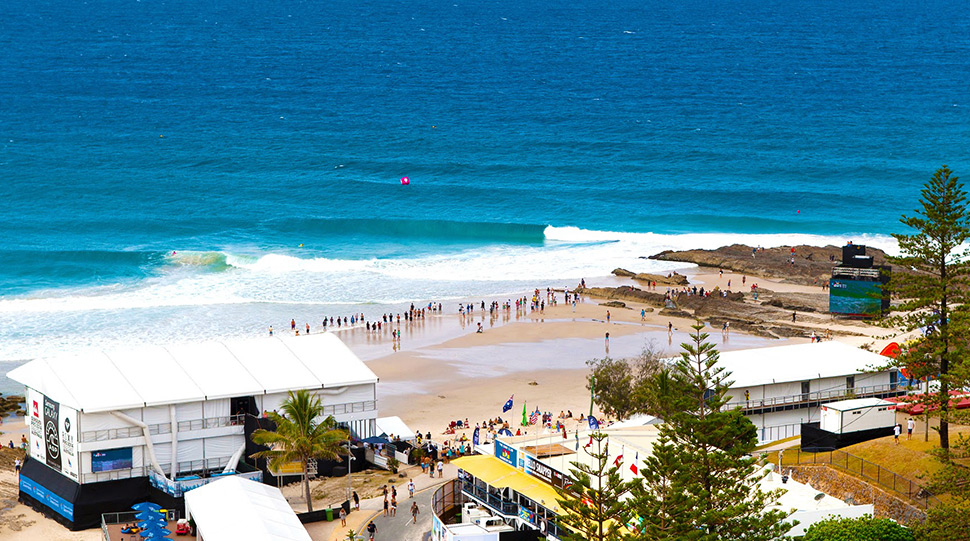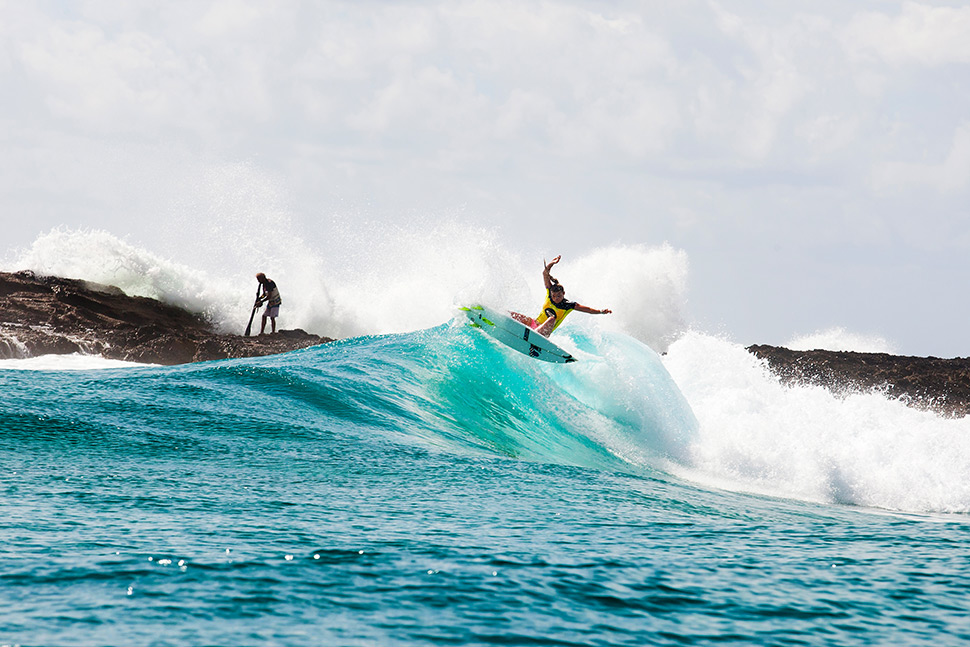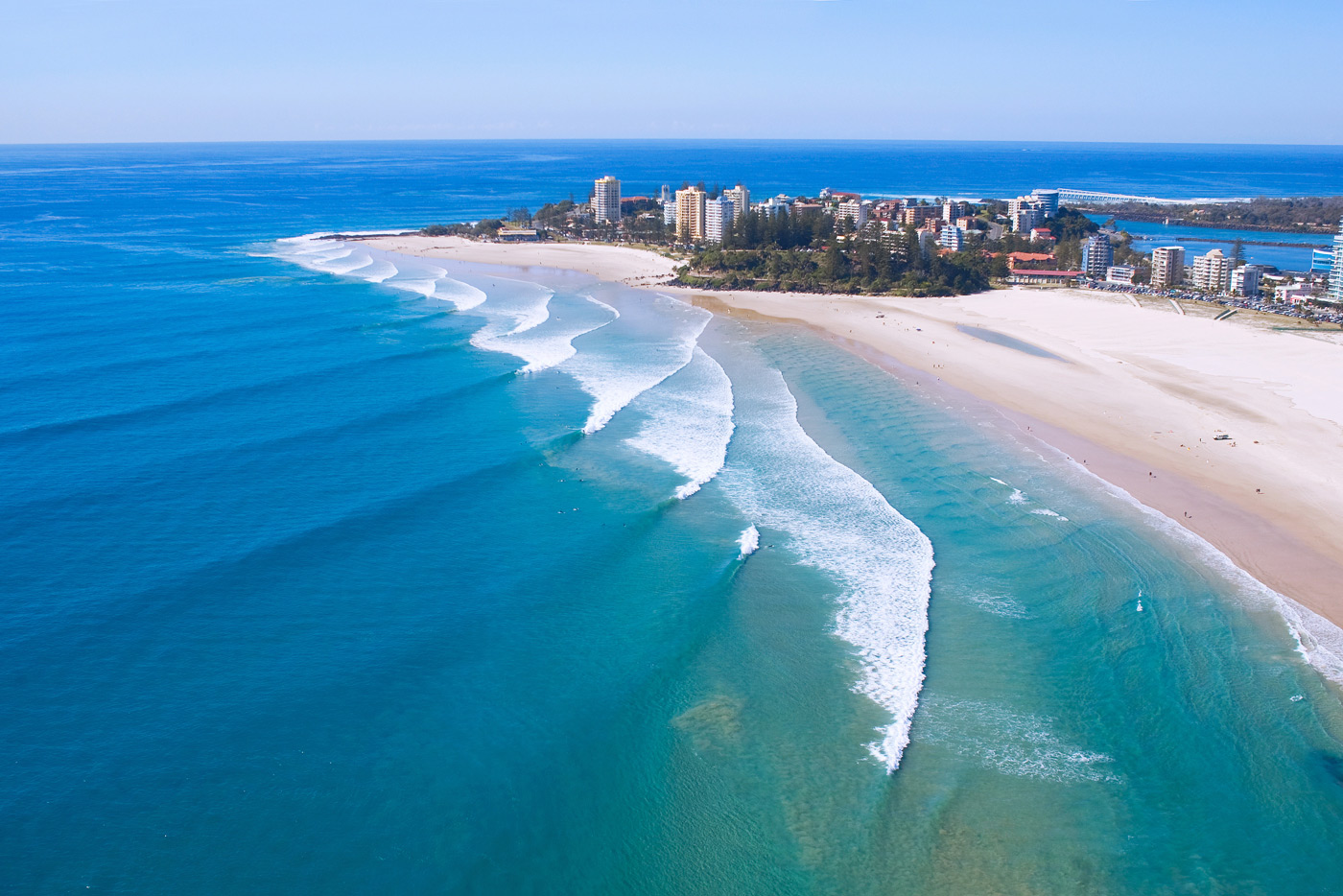Snapper Rocks / Australia – Surf,Bodyboard,SUP – Coolangatta – Gold Coast – Queensland

 Surfergalaxy
Surfergalaxy 
| Wave | Right Pointbreak |
| Ola | Derecha |
| Wind | SW |
| Tide | Medium - Low |
| Marea | Media - Baja |
| Swell | ESE - SE - ENE |
| Bottom | Sand |
| Fondo | Arena |
| Time of year | From February to May |
| Época del año | Desde Febrero a Mayo |
On an epic day, it can be the longest and best quality point break in the world with barrels and bowls all the way from Snapper Rocks to Kirra. At the Snapper Rocks peak, the strong transition between a depth of 15 feet and the sandbanks just at the peak, in front of the rocks, creates the most difficult section and the one which is often 1 or 2 feet bigger than the rest of Superbank. It’s very difficult to catch a wave because the take off zone is narrow and very technical. The wave has a large variety of sections and begins with a potent drop followed by a very fast section with long tight barrels. As mentioned, it is possible to link up to the gentler Greenmount sections. It’s worth knowing that the first wave is the best of the series because the backwash makes the drop in quite difficult in the following waves.
It’s important to select your wave well at Snappers because the best ones aren’t the biggest, but those that are smaller and start taking shape as they move through the line up. To go in, the safe option is to paddle out from the beach near to the rocks. Those that jump from the rocks in front of the peak know what they are doing because you have to pick the right moment. If it’s a good size, there is usually a very strong current and there is the option of going out by Rainbow Bay and re-entering by the peak. Snapper works with a wide variety of swells. The S swell comes parallel along the coast from the Tasmanian Sea, and is more probably during April and September. The periods reach 16 seconds and the waves open quite well although they aren’t as hollow, giving perfect conditions for longboards. The ESE swells form in cyclones around New Zealand’s North Island between December and June, and they are quite consistent, usually lasting for more than a week.
The conditions of these swells change constantly and they can reach more than 6 feet with periods between 12 and 15 seconds, producing waves that improve their shape along the way. The ENE swell forms in cyclones that are generated around New Caledonia. These are the best for some because the sections are more difficult and they offer unpredictable barrels with double up sections, there are less currents and the lower periods mean that the waves split, meaning more people can catch them. The NNE swell, which is more common between September and December, has less quality but generates fun waves with the advantage that there is no current, and although the waves are more unpredictable, there are opportunities for all. The best conditions are usually in autumn, from February until April. It’s the cyclone season and the main swell direction, SE-ESE, is predominant. The best is with a mid tide that is falling and the best size is from 4 to 6 with S-SW breezes, which are more frequent between May and September. The SE breezes aren’t too bad in the last sections and these are more frequent between January and April. When there is less swell, Duranbah (D-bah) is the best option. It’s a beachbreak with various good quality peaks.
Un día épico puede ser el Pointbreak más largo y de más calidad del mundo, tubos y bowls a todo lo largo desde Snapper rocks hasta Kirra. En el pico de Snapper Rocks la fuerte transición entre 15 pies de profundidad y el banco de arena justo en el pico enfrente de las rocas crea la sección más difícil y en la que suele haber 1 o 2 par pies más de tamaño que en el resto de Superbank. Es muy difícil poder coger una ola porque la zona de take off es estrecha y muy técnica. La ola posee gran variedad de secciones y empieza con un potente drop al que le sigue una sección muy rápida en la que caen largos y ajustados barrels. Como ya hemos dicho eventualmente será posible enlazar con las secciones más suaves de Greenmount. Un consejo es saber que la mejor ola es la primera de la serie porque en las siguientes el back-wash dificulta bastante el drop-in. En Snappers es importante seleccionar bien tu ola porque las mejores no son las más grandes, sino aquellas que empiezan más pequeñas y van cogiendo forma conforme avanzan por el line-up. Para entrar lo más fácil es por la playa cerca de las rocas, los que saltan desde las rocas en frente del pico saben lo que hacen porque hay que escoger bien el momento. Si hay buen tamaño la corriente suele ser muy fuerte y compensa salir por Rainbow Bay para volver a entrar por el pico.
La variedad de swell que hacen funcionar la máquina de Snapper es amplia. El swell de sur viene paralelo a la costa desde el Mar de Tasmania, más probable entre abril y septiembre, sus periodos alcanzan los 16 segundos y sus olas abren bastante bien aunque son menos huecas, son condiciones preferidas por longboards. El swell de ESE se forman en ciclones alrededor de North Island en Nueva Zelanda entre diciembre y junio, son bastante consistentes durante más de una semana, las condiciones de estos estos swell cambian constantemente y pueden alcanzar más de 6 pies con periodos entre 12 y 15 con olas que mejoran su forma a lo largo de su recorrido. El swell de ENE se forma en ciclones generados alrededor de Nueva Caledonia. Para algunos son los mejores porque las secciones son más difíciles y ofrecen imprevisibles barrels con secciones double up, no hay tanta corriente y el menor periodo hace que las olas se partan permitiendo que más gente pueda coger olas El swell NNE es el de menos calidad pero genera olas divertidas con la ventaja de que no hay corriente y al ser sus olas aún más imprevisibles dan oportunidades a todos, estos son más usuales entre septiembre y Diciembre.
Las mejores condiciones suelen darse en otoño desde febrero a abril, esta es temporada de ciclones y predomina la mejor dirección de swell desde SE- ESE. La mejor marea para surfear es la media bajando y el mejor tamaño es de 4 a 6 con brisas de S- SW que entre mayo y septiembre son frecuentes, entre enero y abril es más frecuente las brisas de SE que tampoco son malas en las secciones finales. Cuando hay poco mar duranbah (D-bah) es la mejor opción, Un Bechbreak muy competitivo con varios picos de mucha calidad.

Snapper Rocks is the crown jewel on the Gold Coast, Eastern Australia. It’s a right with sandy seabed and because of its good banks and shapes, it’s definitely in the top ten of the world’s best rights. It’s located in the coastal city Coolangatta, in the state of Queensland. It’s one of the world’s surf meccas and thousands of surfers from all over the world arrive there for one reason or another. To get there, you can fly to Gold Coast International Airport in Coolangatta or Brisbane Airport. Both are a little over an hour away by car on the M1. If you are coming from Sydney, you could drive the interesting nine hour coastal route along the Pacific Highway. Once you’re in Coolangatta, you can park and look for accommodation around Snapper Rocks Road, crossing Rainbow Bay in the Greenmount area.
Like every world class spot, it has unique characteristics due to its geological origin. Snapper Rocks is the easternmost point of Australia, which emerged 20 million years ago around a volcano near to the coast that configured the coastal profile. Its lava flows left submerged volcanic rock which now accumulate the sand and deposit it along the coastline, depending on the direction of the currents and waves. It all depends on the ocean’s dynamics and the Tweed River mouth which naturally deposits the sandbars at Snappers and the following sections, Greenmount and Kirra. Snappers has always been in the shadow of its sister Kirra, however, in the eighties, the remodelling of the Tweed River mouth to improve the navigability altered the bars and therefore the waves, leaving Kirra the most affected. In 1995, the solution arrived with the installation of an artificial system that dredged the deposited sand from the river mouth and pumped it to the other side creating, little by little, what is now known as Superbank. Superbank is a sandbar that is nearly two kilometres long and, with adequate conditions and a solid swell, the waves can be linked from Snappers, passing Greenmount, until Kirra. This was evident in the autumn of 2002 when the local surfer Damon Harvey surfed from Snapper Rocks to Kirra with a 6 foot swell, a 1.5 km ride which was recorded as the longest wave ever surfed.
Snapper Rocks has been the centre of attention on the Gold Coast since early in the XXI Century, for example, it’s been the fixed host for the first stop of the Quik Pro Gold Coast world tour since 2002. The competitiveness there has forged the surfing of world champions like Mick Fanning, Joel Parkinson and others like Bede Durbige, Julian Wilson, Josh Kerr and Stephanie Gilmore who also stand out in the WCT. Others that took part are the legendary Dean Morrison, Luke Munro and aspiring youngsters like Dale Richards, Blake Ainsworth, Jack Freekstone and Nick Vasicek, who is one of the best backhand. We have to remember the legendary world champions like Peter Townsend and Rabbit Bartholomew, one of the best in the Snapper Rock Surfrider’s club. This is also a spot where some of the best shapers in the world trial their boards, among those are Murray Bourton, Darren Handley, Jason Stevenson, Nev Hyman, Matt ‘Mayhem’ Biolos and others that are less known internationally but very well known among the locals. There are always many people in the water at Snapper Rocks. It’s such a distinguished right that it seems like the surfers queue up for it, and it doesn’t matter if you get up early as there will already be people in the water. Just remember that the large influx, the high level and tradition along the years means that the surfers are well-educated in the water and with respect and being attentive, you’ll enjoy one of the best waves in the world.
Snappers Rocks es la joya de la corona de la costa este de Australia, una barra de derecha con fondo de arena que por sus buenos fondos y formas es sin duda una de las 10 mejores derechas del mundo, se encuentra en la ciudad costera de Coolangatta en el estado de Queensland. En un lugar que es toda una meca del surfing mundial, Son miles de surfers procedentes de todo el mundo los que por un motivo u otro llegan hasta aquí. Para llegar las opciones son varias, hay vuelos hasta el aeropuerto internacional de la Gold Coast en Coolangatta o el de Brisbane a poco más de una hora de coche por la M1. Si vienes desde Sidney es una opción hacer la atractiva ruta de nueve horas que bordea la costa por la Pacific Highway. Una vez en Coolangatta se puede aparcar y encontrar alojamiento alrededor de Snapper Rocks Road cruzando por Rainbow Bay en la zona de Greenmount.
Como cada spot de clase mundial, éste tiene unas características que lo hacen único y que van en relación a su origen geológico. Snapper Rocks es el punto más al este de Australia, una tierra emergida hace 20 millones de años en torno a un volcán cercano a la costa que ha configurado el perfil costero y en el que sus coladas de lava han ido dejando flechas sumergidos de roca volcánica que acumulan y ordenan la arena a lo largo de la línea de costa según el sentido de la corrientes y las olas. Todo depende de la dinámica oceánica y la desembocadura de Tweed River que alimentan de forma natural los fondos de arena de Snappers y de las siguientes secciones de Grennmount y Kirra. Snappers siempre ha vivido a la sombra de su hermana mayor Kirra, sin embargo, en los ochenta la remodelación de la bocana del actual Tweed River para mejorar la navegabilidad del mismo alteró los fondos y por tanto también las olas, siendo sobretodo Kirra la más afectada. La solución llegaría en 1995 con la instalación de un sistema artificial que draga la arena que se deposita en la desembocadura del rio y la bombea hasta el otro lado creando lo que actualmente se conoce como Superbank, un banco de arena de casi dos kilómetros que es capaz, con las condiciones adecuadas, de que las olas lleguen desde Snappers a Greenmount terminando en Kirra. Esto quedó patente en otoño de 2002 cuando el surfer local Damon Harvey con un swell de 6 pies surfeó desde Snapper Rocks hasta Kirra, un 1.5 km de riding que marcó un récord en cuanto a la ola más larga jamás surfeada.
Desde principios del siglo XXI Snapper Rocks es el centro de atención de la Gold Coast y desde 2002 sede fija de la primera parada de la élite del circuito mundial con el ‘Quik Pro Gold Coast’. Aquí se han forjado campeones del mundo como Mick Fanning o Joel Parkinson y otros como Bede Durbige, Julian Wilson, Josh Kerr y Stephanie Gilmore, también otros que ya formaron parte de la élite como el mítico Dean morrison, Luke Munro y jóvenes que aspiran como Dale richards, Blake Ainsworth, Jack Freekstone o Nick Vasicek, uno de los mejores backhand de Snappers. Recordad los legendarios campeones mundiales Peter Townend y Rabbit Bartholomew, uno de los más grandes en Snapper Rock Surfrider’s club. A todo ello se une que este lugar es un test para algunos de los mejores shapers del mundo, entre ellos Murray Bourton, Darren Handley, Jason Stevenson, Nev Hyman, Matt ‘Mayhem’ Biolos y otros menos conocidos internacionalmente pero muy reconocidos localmente. En Snappers Rocks siempre hay mucha gente en el agua, es una derecha tan marcada que parece que los surfistas hacen cola, da igual que madrugues porque habrá gente en el agua, lo mejor es tener en cuenta que la gran afluencia, el alto nivel y la tradición han hecho que aquí a lo largo de los años la educación en el agua sea máxima y con respeto y estando atento disfrutarás de una de las mejores olas del mundo.

The Gold Coast offers a wide range of activities along with surfing. The warm, transparent waters allow you to enjoy the reefs, like the one in Kirra or the ones near to Cook Island. Between June and November, you’ll have the chance to see the humpback whales during their annual migration. Every second Sunday of the month there is a street market at Queen Elisabeth Park, in front of Coolangatta Beach, and it’s a good chance to experience the region’s artistic vibe. If you want to go inland, there are waterfalls, streams, rainforests, and viewing points to see the amazing scenery in the national parks. Swimming in the crystal clear pools in the McPherson mountain range, watching the Cameron Falls, visiting Cedar Creek and Witches in the Tamborine Mountain National Park and enjoying the subtropical rainforest in Lamington National Park are just a few of the options you’ll have besides surfing.
La Gold Coast ofrece un amplio abanico de actividades paralelas a la práctica del surf. Sus aguas cálidas y transparentes permiten que disfrutes de sus fondos marinos como en el arrecife de Kirra o en zonas cercanas a la isla de Cook. Es una realidad la posibilidad de observación de ballenas jorobadas en sus rutas migratorias anuales entre los meses de junio y noviembre. Los segundos domingos de cada mes tiene lugar un mercadillo de arte en el Queen Elisabeth Park, frente a la playa de Coolangatta, una oportunidad estupenda para tomarle el pulso a la actividad artística de la región. Si lo que prefieres en el interior podrás explorar las cataratas, riachuelos, bosques pluviales, miradores y paisajes escénicos de sus increíbles Parques Nacionales. Nadar en pozas cristalinas de la Cordillera McPherson, ver las cataratas Cameron, Cedar Creek y Witches en el P.N Tamborine Moutain y disfrutar de los árboles legendarios del P.N Lamington son algunas de las opciones de las muchas existentes.